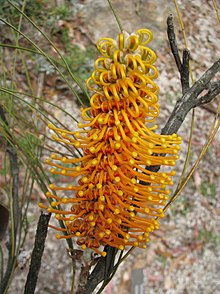bio.wikisort.org - Plant
Grevillea excelsior, commonly known as flame grevillea[2] or yellow flame grevillea,[3] is a species of flowering plant in the family Proteaceae and is endemic to the south-west of Western Australia. It is an erect shrub or small tree with usually divided leaves with linear lobes, and clusters of orange flowers.
Description
Grevillea excelsior is an erect shrub or tree that typically grows to a height of 1–8 m (3 ft 3 in – 26 ft 3 in) and has a leafy base with emergent flower spikes. The leaves are 50–300 mm (2.0–11.8 in) long and usually divided with two to seven linear lobes, sometimes divided again. The undivided leaves and lobes are mostly 1–2 mm (0.039–0.079 in) wide with the edges rolled under, enclosing the lower surface apart from the midvein. The flowers are arranged in conical to oblong clusters on a peduncle 10–40 mm (0.39–1.57 in) long, the rachis 80–200 mm (3.1–7.9 in) long. The flowers are pale orange on the outside, brighter inside, with a bright orange style, the pistil 20–29 mm (0.79–1.14 in) long. Flowering mainly occurs from August to November and the fruit is a hairy follicle 15–22 mm (0.59–0.87 in) long.[2][3]
Taxonomy
Grevillea excelsior was first formally described in 1904 by Ludwig Diels in Ernst Georg Pritzel's Botanische Jahrbücher für Systematik, Pflanzengeschichte und Pflanzengeographie.[4][5] The specific epithet (excelsior) means "taller".[6]
Distribution and habitat
Flame grevillea grows in mallee heath and is widespread in inland areas of south-western Western Australia between Quairading, Wongan Hills, Coolgardie and the Peak Charles National Park.[3][2]
Conservation status
Grevillea evanescens is listed as "not threatened" by the Government of Western Australia Department of Biodiversity, Conservation and Attractions.[2]
References
- "Grevillea excelsior". Australian Plant Census. Retrieved 17 April 2022.
- "Grevillea excelsior". FloraBase. Western Australian Government Department of Biodiversity, Conservation and Attractions.
- "Grevillea excelsior". Australian Biological Resources Study, Department of Agriculture, Water and the Environment: Canberra. Retrieved 17 April 2022.
- "Grevillea excelsior". APNI. Retrieved 17 April 2022.
- Diels, Ludwig (1904). "Fragmenta Phytographiae Australiae occidentalis. Beitrage zur Kenntnis der Pflanzen Westaustraliens, ihrer Verbreitung und ihrer Lebensverhaltnisse". Botanische Jahrbücher für Systematik, Pflanzengeschichte und Pflanzengeographie. 35 (1): 151. Retrieved 17 April 2022.
- Sharr, Francis Aubi; George, Alex (2019). Western Australian Plant Names and Their Meanings (3rd ed.). Kardinya, WA: Four Gables Press. p. 195. ISBN 9780958034180.
Другой контент может иметь иную лицензию. Перед использованием материалов сайта WikiSort.org внимательно изучите правила лицензирования конкретных элементов наполнения сайта.
WikiSort.org - проект по пересортировке и дополнению контента Википедии
